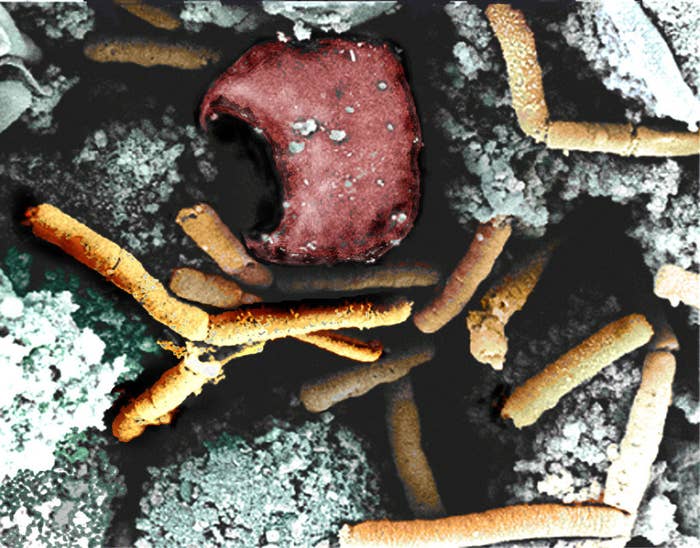
A U.S. biodefense lab's mistaken shipments of living anthrax to labs worldwide included an especially deadly strain of the bug.
Some scientists fear that this mistake was not just a matter of laboratory error, as the Pentagon claims. The tainted shipments, they warn, may have caused widespread contamination of many U.S. biodefense facilities with the infamous "Ames" strain of anthrax, which in 2001 killed five people after it was sent by mail to several lawmakers and journalists.
"There's virtually no justification for sending virulent anthrax" to test detection methods, even if defense scientists thought the bacteria was dead, Richard Ebright, a chemical biologist at Rutgers University, told BuzzFeed News. Spore inactivation methods were known to be imperfect, and harmless anthrax strain spores could have been used in tests instead, he added.
"If ISIS or Al-Qaeda acquires Ames anthrax it will likely be through this incident," Ebright said.
Live spores of anthrax sent from the the U.S. Army's Dugway Proving Grounds in Utah may have reached 68 other labs — spread across 19 states and four foreign countries — over the last decade, according to the Pentagon's latest count in its investigation. Shipments to at least 24 of the labs included the notorious Ames strain.
Ironically, Dugway sent the samples to labs "as part of a program to develop biological detection technology for protective purposes," according to a Defense Department statement sent to BuzzFeed News. That program stopped on May 22, when the Centers for Disease Control and Prevention alerted the Defense Department that lab workers in Maryland discovered a live anthrax sample.
In a June 3 briefing, Deputy Defense Secretary Bob Work emphasized that the concentration of spores in the samples were too low to infect healthy people, showed no sign of leaving any of the labs, and posed "no public health risk." Thirty-one lab workers potentially exposed to samples containing living anthrax were put on antibiotics as a precautionary measure.
Because the bugs were presumed dead, "they were able to be sent further down" to more labs without regulation, Stephen Redd of the Centers for Disease Control and Prevention said at the briefing.
The Defense Department shut down all of its anthrax experiments as part of a review. The first question in the investigation, Work said, was "Why didn't we kill the spores?" (As BuzzFeed News reported last week, Anthrax is a particularly resilient bug.)
But scientists like Ebright have sharply criticized the investigation, which has so far focused on technical failures and largely ignored questions of whether the vast biodefense lab network itself posed a risk. With that approach, Ebright said, "this sort of thing is just going to happen again and again."

More than 300 labs nationwide are accredited to handle anthrax, according to a 2013 Government Accountability Office report.
Typically detection tests for anthrax are triggered both directly by bacterial DNA and indirectly by chemical reactions to the bug triggered by immune cells fighting an infection.
Even 99.999% effective anthrax inactivation methods leave some living spores behind, anthrax expert Martin Hugh-Jones of Louisiana State University in Baton Rouge noted in an online posting to infectious disease experts on Monday. "If they needed a live strain for checking their diagnostic test kits and the competence of the test-kit holders, why did they not use a safe live vaccine [strain]," he asked.
However, Paul Keim, an anthrax expert at Northern Arizona University in Flagstaff, told BuzzFeed News that it's possible that some of the recipients of the bugs wanted to study DNA present only in deadly strains.
Those tests might help distinguish dangerous anthrax releases from false alarms triggered, for example, by vaccine strains available in veterinary supply stores. "We don't know if that is what they were doing, but the method would have to be tested with inactivated spores to make sure it works," Keim added.
Of course, the question of deadly versus safe strains wouldn't matter if the spores in the shipments had actually been inactivated, Kenneth Berns, head of the American Society for Microbiology's biodefense committee, told BuzzFeed News by email. Berns said that he does not view the shipments of potentially living Ames samples with as much concern as the revelation that blasting spores with gamma radiation failed to kill them.
Regardless, one result of the Defense Department investigation might be the eventual decision to switch to tests that rely on safer strains, out of an abundance of caution, Keim added.
"There isn't anything good about sending out living [anthrax] spores, but there isn't any imminent danger either," Keim said. An ongoing MERS outbreak in South Korea has killed seven people and put 2,800 in quarantine. "That's what a serious public health risk looks like."
